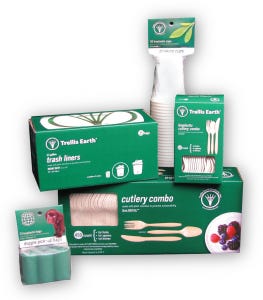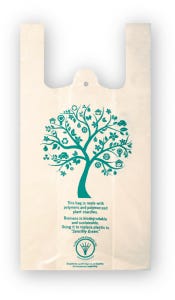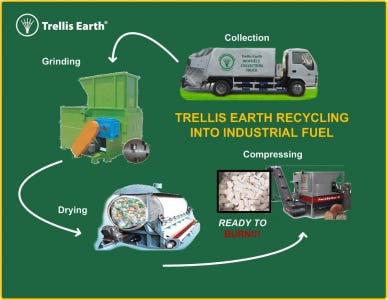The Bioplastics Burden
The growing volume of bioplastics in the waste stream poses concerns — as well as opportunities — for recyclers and composters.
September 1, 2011
Mary Catherine O'Connor
The market for bioplastics is expected to quadruple in the next decade, as the materials capitalize on their appeal to consumers, retailers, and subsequently the packaging industry. Yet this environmentally friendly antidote to conventional plastic is starting to raise concerns for some waste haulers, reclaimers and composters because of bioplastics’ varied end-of-life requirements.
Market Potential
Bioplastic and “eco-friendly plastic” are ubiquitous in headlines and marketing materials because plastics derived from renewable biomass sources, such as vegetable fats and oils, and cornstarch, are much easier to feel good about than plastics that are derived from petroleum. Some bioplastics offer the added benefit of decomposing in natural aerobic and anaerobic environments.
Yet bioplastics still comprise little of the stuff Americans interact with on a daily basis. Globally, bioplastics account for less than 1 percent of the 230 million tons of plastic produced each year. The U.S. bioplastics market is less than half of that 1 percent, according to plastics industry analyst Jim Lunt of Wayzata, Minn.-based Jim Lunt & Associates.
Concerns, nevertheless, are being raised because of bioplastics’ expected market growth, and because of the fact that a range of materials using the bioplastics moniker actually have different compositions. For instance, some bioplastics, such as polylactic acid (PLA), can be composted but not recycled (at least, not along with conventional plastic). Others are chemically identical to conventional plastics so can only be recycled and not composted. And when compostable materials end up in recycling streams, or vice versa, the contamination costs material-handlers money — and leads to waste.
Co-Mingling Migraines
PLA is a rigid thermoplastic polymer derived from lactic acid and is one of the oldest and most prevalent bioplastics used in packaging. PLA became commercially viable in 1997 when Cargill and Dow Chemical Company formed a subsidiary and patented a process for deriving lactic acid from dextrose. (Dow later divested from the effort and Cargill renamed the company NatureWorks.)
Today, NatureWorks’ Ingeo brand of PLA is used to package many consumer goods and single-serve food service items. Walmart, for example, uses PLA to package fresh items in some stores. NatureWorks’ production capacity is 140,000 tons per year, which it hopes to expand to accommodate rising sales.
Cereplast is another manufacturer of plastic resins that contain PLAs and other bio-based resins — in some cases mixed with conventional plastic resins. The company says a new plant being built in Indiana will boost its U.S. output to 80 million pounds (40,000 tons) per year. And there are scores of other bioplastic resin companies, both in the United States and abroad.
 Because manufacturers sell only the resin, which converters then form into products, such as packaging, it is difficult to determine how much PLA ends up in the waste stream. What is known is that within a materials recovery facility (MRF), PLA looks and acts like polyethylene terephthalate (PET) — much more so than other bioplastics such as polyhydroxyalkanoate (PHA) or polyhydroxybutyrate (PHB), says David Cornell, technical director of The Association of Postconsumer Plastic Recyclers. The latter materials are not clear, and are therefore easily culled through manual screening.
Because manufacturers sell only the resin, which converters then form into products, such as packaging, it is difficult to determine how much PLA ends up in the waste stream. What is known is that within a materials recovery facility (MRF), PLA looks and acts like polyethylene terephthalate (PET) — much more so than other bioplastics such as polyhydroxyalkanoate (PHA) or polyhydroxybutyrate (PHB), says David Cornell, technical director of The Association of Postconsumer Plastic Recyclers. The latter materials are not clear, and are therefore easily culled through manual screening.
Manual sorting can remove some PLA from the recycling stream — especially things like plastic cups that look different from PET bottles. But it gets dicey from there. PLA and PET thermoforms look similar to the naked eye. Like PET, PLA will sink in a float-sink separator, used to cull materials such as high-density polyethylene (HDPE) and polypropylene (PP) out of batches of PET.
PLA isn’t the first material to cause recyclers headaches. Polyvinyl chloride (PVC) has been the bane of PET recyclers since the beginning of PET recycling because it, too, sinks in a float-sink separator. But while PVC usage is in decline, PLA appears to be increasing, says Cornell.
“PLA melts at the operating temperature of the PET dryers,” Cornell says. This causes it to damage PET dryers and makes the dryers difficult to use.
If a reclaimer detects the presence of PLA in a PET bale that it has already paid for, it will incur extra costs by removing traces of PLA so the PET retains value (and so it reduces the likelihood that the recycled material may cloud up and appear sub-standard). But the quantity of removed PLA is generally too small to justify trying to recycle it (more on Biocor’s efforts on this front below), so the material incurs costs but no value.
“If I’m a recycler and I end up with PLA in my [end] product and I sell it to you, and you make thermoforms for, say, bakery muffins, you’ll take my product and say, ‘Hey this has a streak of haze in it,’” Cornell says.
In other words, recyclers would rather lose money by removing contaminants like PLA than risk losing a customer by allowing their products to become degraded.
Separating Problems From Opportunities
It is difficult for plastic recyclers to quantify the problems they are experiencing with PLA and other bioplastics, because when PET or other streams are muddled, pinpointing the contamination source is challenging.
“Reclaimers say they have contamination problems that they think are due to PLA, but it could be other things, such as PVC or polystyrene, which is being used more in thermoforms,” Cornell says.
In any case, he says, bioplastic contaminants in the PET stream are a nuisance to recyclers — and they will remain so until they become an opportunity. If new materials begin arriving in large-enough quantities, recyclers will have an opportunity to turn a contaminant into a new revenue stream.
This, of course, requires two things. One: investments in sorting equipment. Near-infrared sorters have been shown to effectively separate PLA from PET, but they come at a steep price — upward of $200,000. And two: a secure, steady stream of the material.
When PVC started cropping up in packaging materials, “people invested millions on [sorting infrastructure] but there simply wasn’t enough” of the material to generate a new revenue stream, says Nina Bellucci Butler, principal consultant for Sonoma, Calif.-based Moore Recycling Associates.
While it’s a safe bet that contamination will always exist in any recycling stream, there’s no guarantee that the volume of PLA or other bioplastics will become large enough to make it economically viable to divert and recycle.
Still, that’s what NatureWorks would like. While there are only two commercial facilities in the world (one in Wisconsin and the other in Belgium) that convert large volumes of PLA back into lactic acid, NatureWorks is hoping to help establish a PLA recycling infrastructure. After all, recapturing each molecule and turning it back into PLA saves NatureWorks the time, energy and expense of teasing the material out of corn dextrose.
Biocor, a Northern California startup, is trying to establish a PLA recycling infrastructure as well, and is working with facilities and municipalities to divert and send waste PLA to the Wisconsin recycler. At some event spaces, such as sports stadiums, PLA cups are often used to serve beverages, resulting in a high concentration of PLA waste. So diverting and collecting large volumes of PLA is possible. But it remains to be seen whether Biocor will succeed in attaining the critical mass it needs to make PLA collection for recycling a viable business.
Fine-Tuning Feedstocks
While recyclers may have a difficult time weeding out nonrecyclable bioplastics, there also are challenges to separating non-compostable bioplastics from organic waste bound for industrial compost systems. Many compost facility managers are not keen on having to determine which packaging present in truckloads of food and yard waste is actually compostable bioplastic (denoted by a stamp of certification to the American Society for Testing and Materials D6400 compost standard). Some facilities screen out all packaging — including PLA and other compostable packaging — rather than take the time to determine what materials can remain.
Nevertheless, bioplastic materials such as compostable trash can liners — Telles makes a popular line of these called Mirel bags — are widely used by residents in areas with municipal composting, such as San Francisco, and by restaurants that want to (or are required to) divert food waste for composting. This helps to increase the amount of food waste sent to composting facilities, because residents and businesses dislike placing food waste in containers that need to be cleaned out, once emptied.
 However, the U.S. Department of Agriculture’s National Organic Program (NOP) recently told organizations that sell compost to growers of USDA-certified organic products that they should not allow any compostable bioplastics to be part of the feedstock for “organic” compost. Bioplastics — even those that have been proven nontoxic and compostable — are considered synthetic materials and are not listed as being a safe input for organically grown products.
However, the U.S. Department of Agriculture’s National Organic Program (NOP) recently told organizations that sell compost to growers of USDA-certified organic products that they should not allow any compostable bioplastics to be part of the feedstock for “organic” compost. Bioplastics — even those that have been proven nontoxic and compostable — are considered synthetic materials and are not listed as being a safe input for organically grown products.
Will Bakx, soil scientist and operations manager at Sonoma Compost Co. in Petaluma, Calif., which makes and markets organic compost, says that not being able to accept food scraps in compostable bags has significantly reduced his feedstock. “We lost a number of accounts for food scraps coming into our facility because the companies send them to us in compostable bags,” he says.
Bakx is part of a working group of the U.S. Composting Council that is planning to petition the NOP to make an exemption for ASTM-certified compostable bag liners. The group hopes that the USDA will lift its ban on compostable bioplastics and allow sellers of organic compost to include them in feedstock.
Beyond the Grave
Whether diverted from compost feedstock or tossed directly into the trash, the lifecycle of compostable bioplastic doesn’t end in the landfill. Eventually compostable bioplastic in landfills degrades through anaerobic digestion. Because the byproduct of this process is methane (as opposed to the carbon dioxide and water byproducts of aerobic digestion in a compost system), researchers have raised red flags about the potential harm bioplastics could cause; not all landfills have methane-capture systems.
While researchers have raised the specter of bioplastics contributing to global warming, Steve Mojo, executive director of the Biodegradable Products Institute, points out on the BPI website that the amount of bioplastic in landfills is “miniscule” — especially compared to the 33.4 million tons of methane-producing food waste that ends up in landfills.
Picky Eaters
Oregon-based Trellis Earth makes bioplastic products that combine bio-based and conventional plastic, and are therefore neither recyclable nor compostable. Thus, it is looking for ways to divert its products from landfills to create a new energy source.
 For instance, the company conducted a pilot project with a chain of quick-service restaurants that use its disposable packaging products — including trash can liners. During the trial, Trellis collected the restaurant’s waste material — food scraps, napkins and all — and shredded, then compressed the material into fuel pellets.
For instance, the company conducted a pilot project with a chain of quick-service restaurants that use its disposable packaging products — including trash can liners. During the trial, Trellis collected the restaurant’s waste material — food scraps, napkins and all — and shredded, then compressed the material into fuel pellets.
“We wanted to send these fuel pellets to a coal burning power plant” or use them for some other type of fuel, says Trellis’ CEO Bill Collins. But then Trellis ran into a roadblock. “We started to run afoul of city councils that we approached about our plan to collect this material,” he says. “Because cities have contracts with collectors who get paid by the ton to take this stuff to the landfill, it’s a conflict of interest with the carting companies.”
Despite the recycling and composting challenges, bioplastics are not going to disappear. NatureWorks, BASF and many major corporations have heavily invested money and resources into bioplastics. Dow also recently re-invested in a bioplastic venture.
And the field of green chemistry is growing fast. According to a Pike Research report released early this year, the green chemistry market is $2.8 billion now and should hit about $100 billion by 2020. Researchers are busy developing new bioplastics in an effort to find more sustainable feedstocks (agricultural waste rather than dextrose from corn, for example) and better performance, such as higher heat resistance.
The bioplastics market is pegged to grow more than 400 percent by 2020, according to Jim Lunt & Associates — which means the number of types of bioplastics in the waste stream also may multiply. As that happens, solutions for deriving value from bioplastics at the end of their useful lives may grow, as well.
Mary Catherine O’Connor is a freelance journalist based in San Francisco.
You May Also Like


